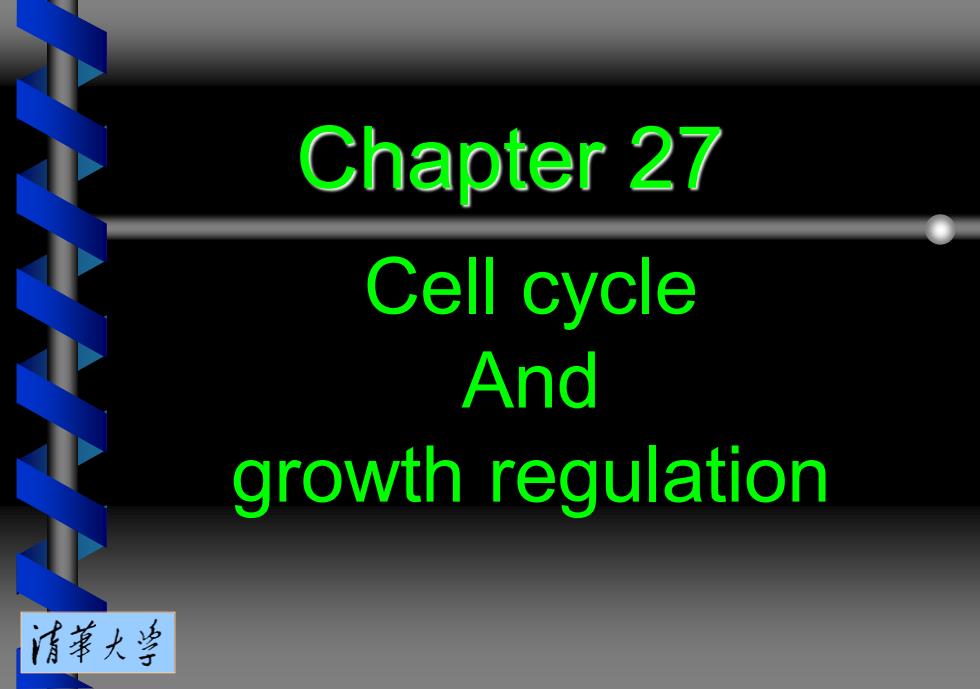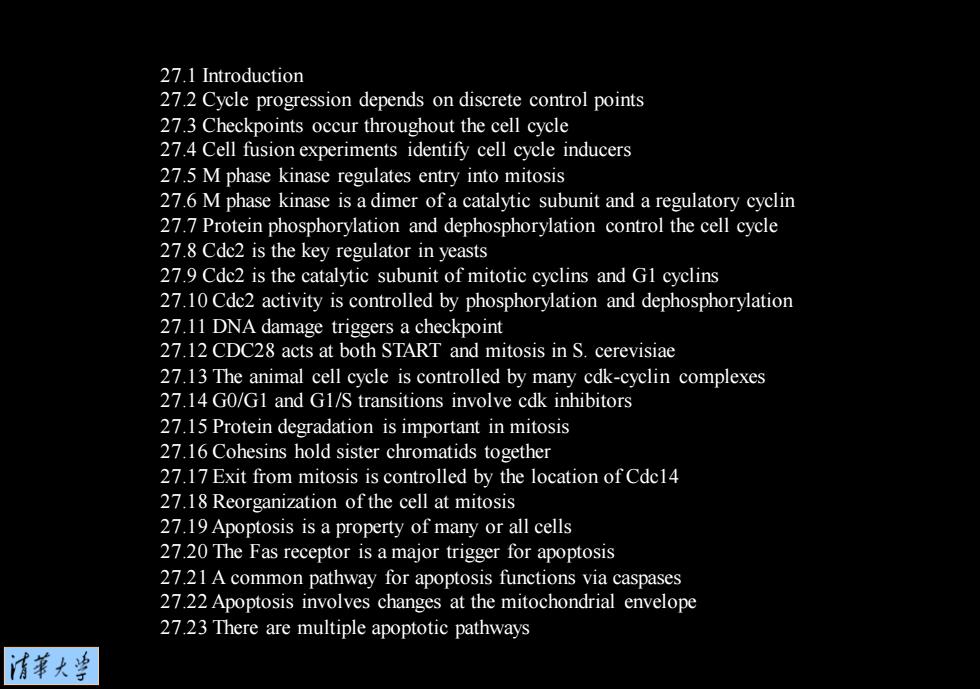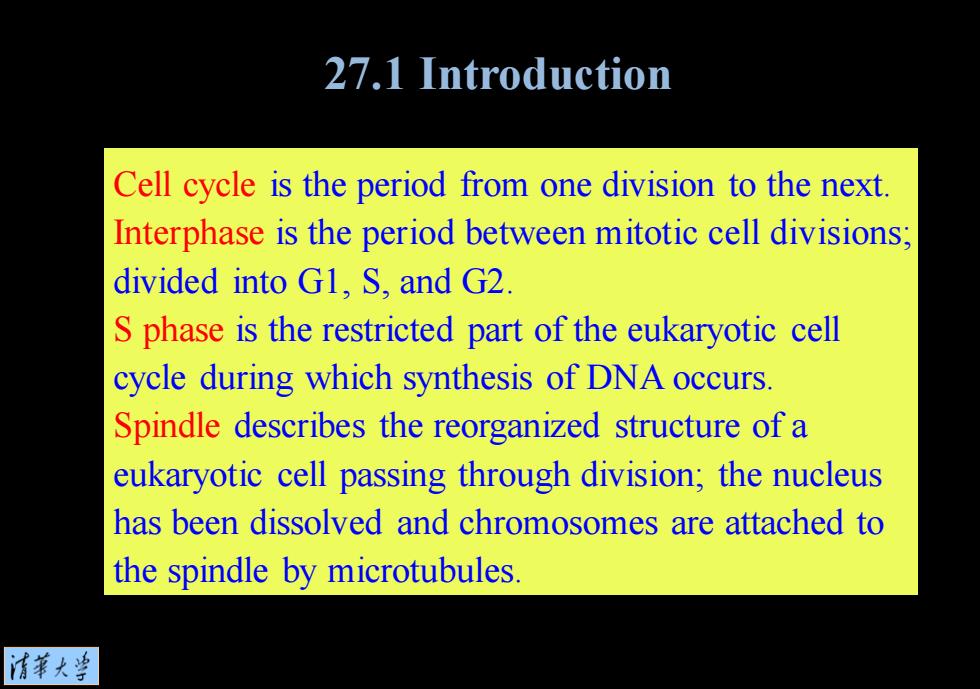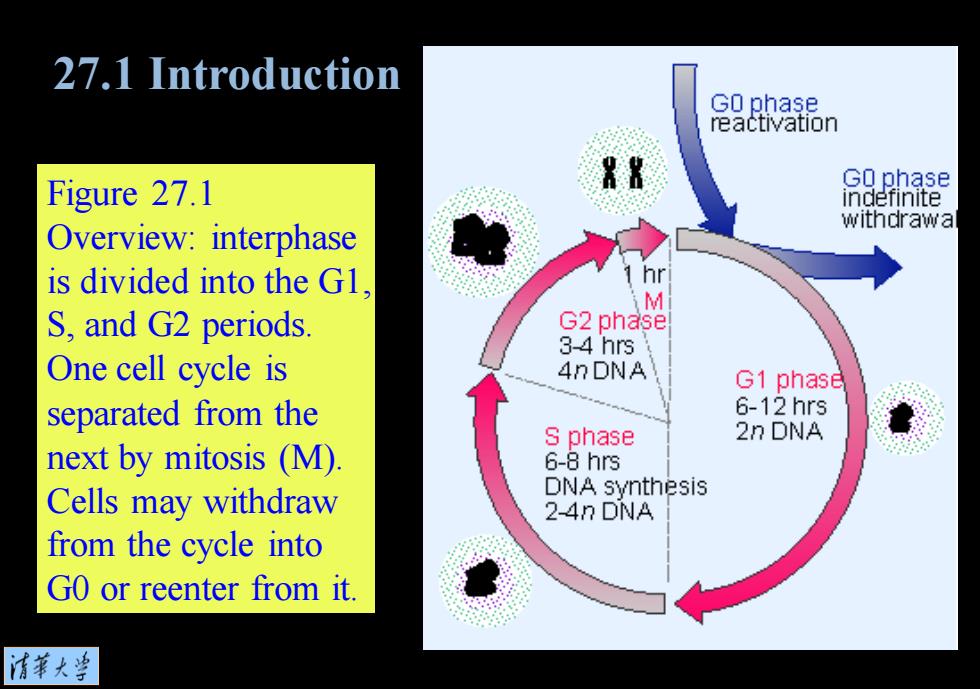
Chapter 27 Cell cycle And growth regulation 清革大当
Chapter 27 Cell cycle And growth regulation

27.1 Introduction 27.2 Cycle progression depends on discrete control points 27.3 Checkpoints occur throughout the cell cycle 27.4 Cell fusion experiments identify cell cycle inducers 27.5 M phase kinase regulates entry into mitosis 27.6 M phase kinase is a dimer of a catalytic subunit and a regulatory cyclin 27.7 Protein phosphorylation and dephosphorylation control the cell cycle 27.8 Cde2 is the key regulator in yeasts 27.9 Cde2 is the catalytic subunit of mitotic cyclins and Gl cyclins 27.10 Cdc2 activity is controlled by phosphorylation and dephosphorylation 27.11 DNA damage triggers a checkpoint 27.12 CDC28 acts at both START and mitosis in S.cerevisiae 27.13 The animal cell cycle is controlled by many cdk-cyclin complexes 27.14 G0/G1 and G1/S transitions involve cdk inhibitors 27.15 Protein degradation is important in mitosis 27.16 Cohesins hold sister chromatids together 27.17 Exit from mitosis is controlled by the location of Cdc14 27.18 Reorganization of the cell at mitosis 27.19 Apoptosis is a property of many or all cells 27.20 The Fas receptor is a major trigger for apoptosis 27.21 A common pathway for apoptosis functions via caspases 27.22 Apoptosis involves changes at the mitochondrial envelope 27.23 There are multiple apoptotic pathways 情菜大当
27.1 Introduction 27.2 Cycle progression depends on discrete control points 27.3 Checkpoints occur throughout the cell cycle 27.4 Cell fusion experiments identify cell cycle inducers 27.5 M phase kinase regulates entry into mitosis 27.6 M phase kinase is a dimer of a catalytic subunit and a regulatory cyclin 27.7 Protein phosphorylation and dephosphorylation control the cell cycle 27.8 Cdc2 is the key regulator in yeasts 27.9 Cdc2 is the catalytic subunit of mitotic cyclins and G1 cyclins 27.10 Cdc2 activity is controlled by phosphorylation and dephosphorylation 27.11 DNA damage triggers a checkpoint 27.12 CDC28 acts at both START and mitosis in S. cerevisiae 27.13 The animal cell cycle is controlled by many cdk-cyclin complexes 27.14 G0/G1 and G1/S transitions involve cdk inhibitors 27.15 Protein degradation is important in mitosis 27.16 Cohesins hold sister chromatids together 27.17 Exit from mitosis is controlled by the location of Cdc14 27.18 Reorganization of the cell at mitosis 27.19 Apoptosis is a property of many or all cells 27.20 The Fas receptor is a major trigger for apoptosis 27.21 A common pathway for apoptosis functions via caspases 27.22 Apoptosis involves changes at the mitochondrial envelope 27.23 There are multiple apoptotic pathways

27.1 Introduction Cell cycle is the period from one division to the next. Interphase is the period between mitotic cell divisions; divided into G1,S,and G2. S phase is the restricted part of the eukaryotic cell cycle during which synthesis of DNA occurs. Spindle describes the reorganized structure of a eukaryotic cell passing through division;the nucleus has been dissolved and chromosomes are attached to the spindle by microtubules. 清苇大当
Cell cycle is the period from one division to the next. Interphase is the period between mitotic cell divisions; divided into G1, S, and G2. S phase is the restricted part of the eukaryotic cell cycle during which synthesis of DNA occurs. Spindle describes the reorganized structure of a eukaryotic cell passing through division; the nucleus has been dissolved and chromosomes are attached to the spindle by microtubules. 27.1 Introduction

27.1 Introduction GO phase reactivation Figure 27.1 GO phase indefinite withdrawa Overview:interphase is divided into the GI M S,and G2 periods. G2 phase 3-4hs One cell cycle is 4nDNA G1 phase separated from the 6-12hrs S phase 2n DNA next by mitosis (M). 6-8 hrs Cells may withdraw DNA synthesis 2-4n DNA from the cycle into GO or reenter from it. 情菜大当
Figure 27.1 Overview: interphase is divided into the G1, S, and G2 periods. One cell cycle is separated from the next by mitosis (M). Cells may withdraw from the cycle into G0 or reenter from it. 27.1 Introduction

G1 phase S phase G2 27.1 Introduction Mass 32 Protein Figure 27.2 Synthesis of RNA and proteins occurs continuously, 16 but DNA synthesis RNA occurs only in the discrete period of S 8 phase.The units of DNA mass are arbitrary. 2 0 8 16 24 清菜大当 hours
Figure 27.2 Synthesis of RNA and proteins occurs continuously, but DNA synthesis occurs only in the discrete period of S phase. The units of mass are arbitrary. 27.1 Introduction